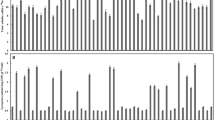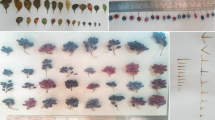Abstract
Guava is rich in antioxidant compounds as it contains a high level of ascorbic acid, carotenoids and phenolic compounds. Genotypic variance, heritability and genetic advance study were carried out to assess the magnitude of variation among the different guava genotypes. High phenotypic and genotypic coefficients of variation were recorded for flavonoids (23.56 and 23.55, respectively) followed by antioxidant activity (18.97 and 18.88, respectively). Heritability and genetic advance (1.00 and 39.51, respectively) were recorded to be highest for flavonoids. Phenotypic coefficient of variance was slightly higher than the genotypic coefficient of variance for all the traits under study, indicating the existence of diversity in guava cultivars. Cluster analysis differentiated guava genotypes into distinct clusters based on flesh and skin colour as well as phytochemical properties. Fruit weight was negatively correlated with antioxidant activity, anthocyanins, lycopene and carotenoid content, which clearly indicates that white-fleshed guavas are larger in size but have lower amounts of these compounds. Correlation studies also revealed that antioxidant activity of fruits was strongly and positively regulated by total phenols, carotenoids and flavonoids. Further, it was worth noting that the ascorbic acid content was also negatively correlated with these phytochemical compounds, which might be due to the fact that the presence of anthocyanins has a negative impact on the presence of ascorbic acid. Thus, the results of the study can be further utilized in guava breeding programmes by understanding the inherent association of important phytochemical traits.



Similar content being viewed by others
Data availability
The authors declare that the data supporting the findings of this study are available within the article.
References
Al-Jibouri HW, Miller PA, Robinson HF (1958) Genotypic and environmental variances and co-variances in an upland cotton cross of interspecific origin. Agron J 50:633
Alam F, Islam KD, Mahbubur RSM (2018) Variability among selective guava (Psidium guajava L.) varieties revealed by morphology and RAPD marker. Jahangirnagar Univ J Biol Sci 7(2):89–98
Angelica MN, Jose HSG, Erica M, Adesio F, Marcia FSF (2012) Discriminant analysis of wild guava tree by morphological descriptors and microsatellites. In: Proceedings of 3rd International Symposium on Guava and Other Myrtaceae, held at Petrolina PE, Brazil
AOAC (2019) Official methods of analysis of the Association of Official Analytical Chemists: Official methods of analysis of AOAC International, 21st edn. AOAC, Washington
Balabaa SI, Zaki AY, ElShamy AM (1974) Total flavonoids and rutin content of the different organs of Sophora japonica L. J Assoc Anal Chem 57:752–755
Bihari M, Suryanarayan (2011) Genetic diversity, heritability, genetic advance and correlation coefficient in guava (Psidium guajava). Indian J Agric Sci 81(2):107–110
DeLacy IH, Basford KE, Cooper M, Bull JK, McLaren CG (1996) Analysis of multi-environment trials—An historical perspective. In: Cooper M, Hammer GL (eds) Plant adaptation and crop improvement. CAB Intl, Wallingford, pp 39–124
Duke GO, George OA, Michael WO, Charles KG, Agnes WM (2022) Physicochemical and processing qualities of guava varieties in Kenya. Int J Fruit Sci 22(1):329–345
Farr JE, Giusti MM (2018) Investigating the interaction of ascorbic acid with Anthocyanins and Pyranoanthocyanins. Molecules 23:744
Flores G, Wu S‑B, Negrin A, Kennelly EJ (2015) Chemical composition and antioxidant activity of seven cultivars of guava (Psidium guajava) fruits. Food Chem 170:327–335
Gaikwad KA, Patil SR, Nagree PK, Potdukhe NR (2018) Morphological characterization of citrus rootstock genotypes. Int J Chem Stud 6:516–529
Gangappa ND, Singh C, Verma MK, Thakre M, Sevanthi AM, Singh R, Srivastav M, Raghunandan K, Anusha C, Yadav V, Nagaraja A (2022) Assessing the genetic diversity of guava germplasm characterized by morpho-biochemical traits. Front Nutr 9:1017680
Hassimotto NM, Genovese MI, Lajolo FM (2005) Antioxidant activity of dietary fruits, vegetables, and commercial frozen fruit pulps. J Agric Food Chem 53:2928–2935
Levy R, Okun Z, Shpigelman A (2019) The influence of chemical structure and the presence of ascorbic acid on anthocyanins stability and spectral properties in purified model systems. Foods 8:207
Lichtenthaler HK, Buschmann C (2001) Chlorophyll and Carotenoids: measurement and characterization by UV-VIS spectroscopy. Curr Protoc Food Anal Chem: F 4.3.1–F 4.3.8
Lima RS, Ferreira SRS, Vitali L, Block JM (2018) May the super fruit red guava and its processing waste be a potential ingredient in functional foods? Food Res Int 115:451–459
Liyana PCM, Shahidi F (2005) Antioxidant activity of commercial soft and hard wheat (Triticum aestivum L.) as affected by gastric pH conditions. J Agric Food Chem 53:2433–2440
Maan SS, Brar JS, Mittal A, Gill MIS, Arora NK, Sohi HS, Chhuneja P, Dhillon GS, Singh N, Thakur S (2023) Construction of a genetic linkage map and QTL mapping of fruit quality traits in guava (Psidium guajava L.). Front Plant Sci 4:1123274
Mishra DS, Berwal MK, Singh Anshuman, Singh AK, Appa Rao VV, Yadav V, Sharma BD (2022) Phenotypic diversity for fruit quality traits and bioactive compounds in red-fleshed guava: Insights from multivariate analyses and machine learning algorithms. S Afr J Bot 149:591–603. https://doi.org/10.1016/j.sajb.2022.06.043
Mulualem T, Mohammed H (2012) Genetic variability and association among yield and yield related traits in Aerial Yam (Dioscorea bulbifera L.) accessions at South-western Ethiopia. J Nat Sci Res 2(9):123–129
Naseer S, Hussain S, Rahman M (2018) The phytochemistry and medicinal value of (Psidium guajava) guava. Clin Phytosci 4:32–34
Omayio DG, Abong GO, Okoth MW, Gachuiri CK, Mwangombe AW (2022) Physicochemical and processing qualities of guava varieties in Kenya. Int J Fruit Sci 22(1):329–345
Rajore M, Kanwar J, Rathore GPS, Kachouli B (2021) Evaluation of guava (Psidium guajava L.) cultivars for morphological, yield and quality attributes under Malwa plateau conditions. J Pharmacogn Phytochem 10(2):483–485
Ramakers JJC, Culina A, Visser ME, Gienapp P (2018) Environmental coupling of heritability and selection is rare and of minor evolutionary significance in wild populations. Nat Ecol Evol 2:1093–1103
Ranganna S (1997) Handbook of analysis and quality control for fruits and vegetable products, 2nd edn. Tata Mac Graw Hill, New Delhi, p 112
Rao AV, Agarwal S (1998) Bioavailability and in vivo antioxidant properties of lycopene from tomato products and their possible role in the prevention of cancer. Nutr Cancer 31:199–203
Raveh E, Goldenberg L, Porat R, Carmi N, Gentile A, La Malfa S (2020) Conventional breeding of cultivated citrus varieties. In: Gentile A, La Malfa S, Deng Z (eds) The citrus genome. Springer, Cham, pp 33–48
Rodriguez MNN, Fermin GA, Valdes-Infante J, Velasquezi B, Rivero D, Martinez F, Rodriguez J, Rohde W (2010) Illustrated descriptors for guava (Psidium guajava). Acta Hortic 849:103–110
Shukla S, Kushwaha R, Singh M, Saroj R, Puranik V, Agarwal R, Kaur D (2021) Quantification of bioactive compounds in guava at different ripening stages. J Food Sci 5:183–189
Silva S, Silva M, Marcal T, Ferreira A, Praca FM, Ferreira M (2017) Genetic parameters of pollen viability in guava (Psidium guajava L.). Aust J Crop Sci 11:1–8
Singh A, Panwar NR, Meghwal PR, Khapte PS, Berwal MK (2019) Bioactive compositions in guava (Psidium guajava) at different stages of maturation in arid conditions. Indian J Agric Sci 89(11):1797–1801
Singh A, Singh G, Kalia A, Rattanapal HS, Gupta M (2020) Leaf morpho-anatomical diversity analysis in mandarin (Citrus reticulata Blanco) genotypes using scanning electron microscopy. Genet Resour Crop Evol 67:2173–2194
Singh D, Gill MIS, Boora RS, Arora NK (2015) Estimates of genetic variability, heritability, genetic advance, correlation coefficients and their prospects for crop improvement in guava (Psidium guajava L.). J App Hortic 17(1):70–75
Singh G, Rattanpal HS, Gupta M, Sidhu GS (2022) Genetic variability and heritability among mandarin (Citrus Reticulata Blanco) genotypes under Indian Sub-Tropical conditions. Appl Ecol Environ Res 20(4):2913–2930
Singleton VL, Orthofer R, Lamuela-Raventos RM (1999) Analysis of total phenols and other oxidation substrates and antioxidants by means of Folin-Ciocalteu reagent. Methods Enzymol 299:152–178
Usman M, Samad WA, Fatima B, Shah MH (2013) Pollen parent enhances fruit size and quality in intervarietal crosses in guava (Psidium guajava). Int J Agric Biol 15:125–129
Yousafi AA, Abbasi KS, Ahmad A, Hassan I, Sohail A, Qayyum A, Akram MA (2021) Physico-chemical and nutraceutical characterization of selected indigenous guava (Psidium guajava L.) cultivars. Food Sci Technol 41:47–58
Acknowledgements
We would like to express our gratitude to the Project Coordinator, All India Coordinated Research Project on Fruits and ICAR for providing funding for the maintenance of guava germplasm in the field gene bank of Punjab Agricultural University, Ludhiana.
Author information
Authors and Affiliations
Corresponding author
Ethics declarations
Conflict of interest
Paras, K. Kaur, G. Kaur, D. Singh and J.S. Brar declare that they have no competing interests.
Additional information
Publisher’s Note
Springer Nature remains neutral with regard to jurisdictional claims in published maps and institutional affiliations.
Rights and permissions
Springer Nature or its licensor (e.g. a society or other partner) holds exclusive rights to this article under a publishing agreement with the author(s) or other rightsholder(s); author self-archiving of the accepted manuscript version of this article is solely governed by the terms of such publishing agreement and applicable law.
About this article
Cite this article
Paras, Kaur, K., Kaur, G. et al. Heritability and Principal Component Analysis of Phytochemical Traits in Guava Under Indian Subtropics. Applied Fruit Science 66, 193–202 (2024). https://doi.org/10.1007/s10341-023-01012-5
Received:
Accepted:
Published:
Issue Date:
DOI: https://doi.org/10.1007/s10341-023-01012-5




